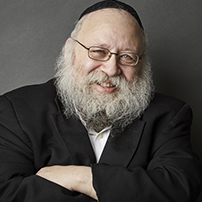
Who’s not for tolerance, unity and love? Yet, the more we seem to be talking about theses ideals, the more splintered and fractured we become as a society. After all, we are all so different. So many opinions, so many personality clashes that these goals seem to be as elusive as ever. To assist us with an understanding of Judaism’s approach to unity, most students of the twin themes of Torah and unity would refer us to the famous Talmudic story of Hillel and the convert. A prospective convert comes to the great Sage Shammai with the demand that he should convert him with the stipulation that he teach him the entire Torah while standing on one foot. Shammai quickly evicts him with the builder’s yardstick in his hand. When the same man comes before Hillel, Hillel graciously accepts him, and acquiesces to his request: “What is hateful to you don’t do to your fellow, this is the entire Torah, the rest is commentary. Go learn the rest.”
Ironically, one could argue that it is from Shammai that we can gain a better understanding of Judaism’s view of unity and the means to implement it. Indeed, a better understanding of Shammai’s perspective on tolerance will shed light on and magnify Hillel’s contribution to the art and science of tolerance and unity as well.
In Ethics of the Fathers (Chapter one) Shammai is quoted as saying, “Greet everyone with a cheerful countenance.” This statement affords us a rather different view of Shammai that goes against the simplistic image of him as an intolerant individual. How do we reconcile this statement with his eviction of the potential convert from his house?
In truth, Shammai does not say simply that we should greet everyone with a cheerful countenance; he says something far more profound that is preserved in the literal translation of the Hebrew words “Kol HaAdam” that is usually rendered “everyone: “Greet the entire person with a cheerful countenance.” When we look at one part of an individual, we can easily define that person by that specific characteristic, belief or practice with which we strongly disagree. Even when we agree with that person’s action or viewpoint and greet him/her accordingly, our acceptance of that person is limited, because it is commensurate with the degree to which our views concur. Total and genuine acceptance of another person can only happen, Shammai seems to be telling us, when we look at the entire individual. Then, we are exposed to the most beautiful of G-d’s creatures, one that was created in the image of G-d.
Shammai’s message is thus: No matter how the person behaves, no matter what are his views, greet the person with a cheerful countenance, because you must look at the totality of that person. Shammai’s lack of tolerance was not directed at the prospective convert, but at his ludicrous and denigrating view of Judaism. To greet him then with a cheerful countenance, Shammai thought, would give the wannabe convert the erroneous impression that his caricature of Judaism was authentic. Shammai was critical and intolerant of the prospective convert’s words, because of their implied disparagement of Judaism. To underscore that his was not a personal animosity, Shammai, therefore, used a measuring stick to evict him. Shammai was simply showing his visitor that his demands did not measure up with the standards of Torah one must have in order to convert.
In Shammai’s philosophy, true unity and tolerance is not antithetical to maintaining strict standards. Shammai was assuredly as loath to compromise the standards of tolerance and unity as he was loath to compromise the standards of Torah To effect unity by compromising one’s principles, is a sign that the unity is at best a superficial one. It is a statement that one’s ability to accept another person is predicated on the watering down of our values and beliefs. And since, we will always find points to disagree about; true unity would always elude us. Ultimate unity and love is expressed when one loves his or her fellow not because s/he is perfect or agrees with my beliefs, but because s/he is endowed with a special soul that is Divine and transcends their flaws and even their virtues. Shammai therefore declares: Greet everyone with a cheerful countenance by looking at the totality of their being, not the degree to which they match our ideals and beliefs.
Hillel, undoubtedly agreed with Shammai’s non-compromising stance. One may never compromise on a principle. Hillel says so much in his famous dictum recorded in Ethics of the Fathers (Chapter one): Love all creatures and bring them close to the Torah.” He emphasized, “bring them close to the torah,” and not “compromise the integrity of Torah so that you can bring it down to their level.” Yet, he accepted the convert who appeared to have been asking for a watered down Judaism.
But herein lies the greatness of Hillel, whose name is etymologically connected to the word light. While Shammai, his rigid devotion to truth and principle notwithstanding, saw beneath the surface of the personalities and was able to separate between their flaws and their pure essence, Hillel was able to extend that to the statements and actions of each and every individual as well. Hillel searched beneath the surface of this convert’s apparent barb directed at Judaism. He applied his spiritual sonar to hear what was really being said. And Hillel was able to detect that deep down there was a pure and holy desire. The irreverent demand to teach him the whole Torah on one foot was only the veneer that belied a much more profound and sincere embrace of Judaism. To remove even that surface resistance to the truth, Hillel employed the path of love and acceptance as he guided the convert on the right path. In Hillel’s approach, one can elicit the inner purity of the soul through tolerance, warmth and expressions of love.
In the final analysis, Both Shammai and Hillel respected, accepted and loved everyone despite their shortcomings. Both Shammai and Hillel would never countenance the compromising of one iota of Torah. The difference between Shammai and Hillel was that Shammai separated people from their views; he accepted people while rejecting their erroneous ideas. Hillel was able to find a spark of positive energy even in words that do not appear to be so positive, and he sought to elicit the true inner desires of the soul through warmth and acceptance.
In conclusion, the invaluable lessons we can learn from both Shammai and Hillel for our fragmented Jewish community are threefold. For unity to be genuine, it must include three elements:
- An acceptance of others even if we totally disagree with them, because of the recognition that there is much more to the person then that which is expressed in their views and behavior.
- True unity does not require that we agree or even respect each other’s views. To generate true unity we do not have to compromise one iota of Torah principles. We accept the totality of the individual even if we cannot accept his/her values. And this is true even in Shammai’s philosophy.
- But, even when we have to disagree with someone’s values and opinions because they contradict the Torah, rather than impugning their motives and denigrating them, we should follow Hillel’s example and attribute their misguided words to an inability to articulate their G-dly soul’s true desire. While never misrepresenting Torah’s values to them, we must enable them to appreciate their own innate spiritual nature that certainly wants to do that which is G-dly and right. The way to achieve this realization, especially in our day and age, is primarily through love and devotion.


